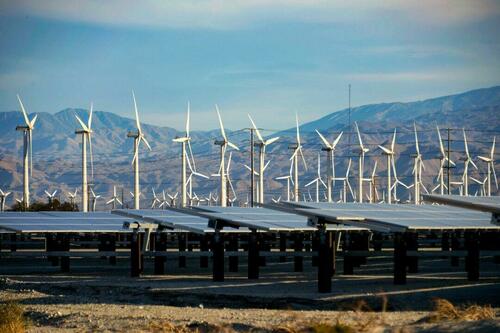Treasury Department Releases New Guidance Restricting Wind, Solar Tax Credits
Authored by Aldgra Fredly via The Epoch Times (emphasis ours),
The Treasury Department on Friday unveiled guidance that tightens the criteria for wind and solar energy projects to receive federal tax credits.

The guidance follows President Donald Trump’s July 7 executive order directing the department to enforce the One Big Beautiful Bill Act he signed into law on July 4, which effectively ends renewable energy tax credits for projects that have not begun construction.
The new rules narrow down the definition of projects considered to have begun construction, replacing the previous rule that allowed developers to qualify after incurring 5 percent of the project costs.
It stated that the “Five Percent Safe Harbor” is no longer available for determining “whether a wind or solar facility has met the beginning of construction deadline and, thus, is not subject to the credit termination date.” However, small projects below 1.5 megawatts could still be considered for the provision.
Developers will need to prove they started “physical work of a significant nature” to establish that solar or wind projects have begun construction, and those projects must be continuous, according to the guidance.
“Provided that physical work performed is of a significant nature, there is no fixed minimum amount of work or monetary or percentage threshold required to satisfy the Physical Work Test,” it stated.
The newly released guidance counts activities such as setting anchor bolts into the ground, excavating land, and pouring concrete pads of the foundation as qualified work in progress.
Preliminary activities such as mapping, clearing a site, test drilling, or excavating to change the contour of the land are not considered as having begun construction, according to the updated rules.
It also stated that solar or wind facilities must be operational by the end of the fourth calendar year after construction begins, in order to fully qualify under the new rules.
The Solar Energy Industries Association (SEIA) criticized the guidance as a “blatant rejection” of congressional approval and said that it threatens small businesses supporting the U.S. clean energy sector.
“American families and businesses will pay more for electricity as a result of this action, and China will continue to outpace us in the race for electricity to power AI,” SEIA CEO Abigail Ross Hopper said in a statement.
Clean Energy Buyers Association CEO Rich Powell said the guidance provides the business community with certainty “by honoring existing contracts” while ensuring proper use of taxpayer money.
“Meeting these new standards will be challenging, but we are confident that American energy buyers will help developers rise to the challenge of delivering all sources of power critical to the continued growth of the U.S. economy,” Powell stated.
The executive order to end federal subsidies for wind and solar energy projects cited concerns over the reliability of these energy sources and dependence on foreign-controlled supply chains.
In his order, Trump stated that reliance on “so-called ‘green’ subsidies” poses a national security risk by making the United States dependent on supply chains controlled by foreign adversaries.
“Ending the massive cost of taxpayer handouts to unreliable energy sources is vital to energy dominance, national security, economic growth, and the fiscal health of the nation,” the order stated.
Tyler Durden
Mon, 08/18/2025 – 12:45ZeroHedge News




 T1
T1



